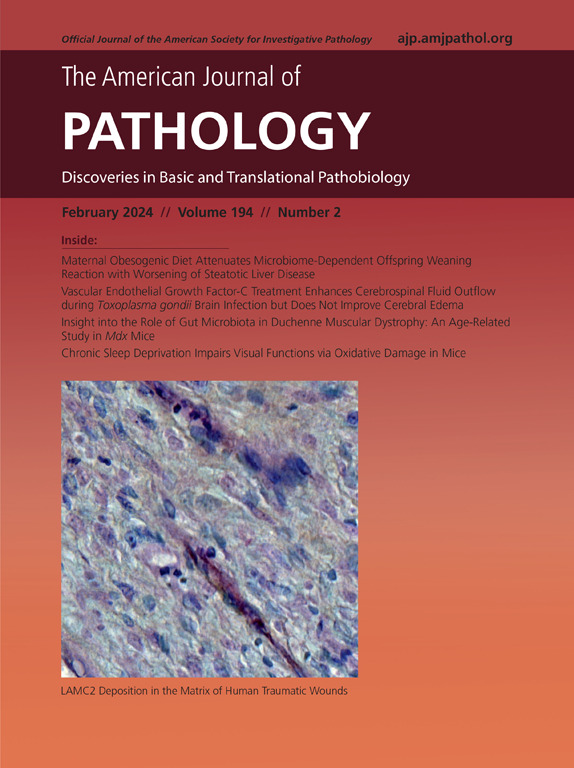Laminin-γ2–NR6A1 Fusion Protein Promotes Metastatic Potential in Non–Small-Cell Lung Carcinoma Cells without Epidermal Growth Factor Receptor Mutation
IF 4.7
2区 医学
Q1 PATHOLOGY
引用次数: 0
Abstract
Laminin-γ2 fusion gene (Lm-γ2F), formed by translocation between LAMC2 and NR6A1, functions as an epidermal growth factor receptor (EGFR) ligand. However, its expression and impact on cancers beyond the initially studied contexts remain unclear. This study focused on Lm-γ2F protein secretion and its role in non–small-cell lung carcinoma (NSCLC), where EGFR signaling plays a pivotal role in malignancy progression. Lm-γ2F secretion was confirmed in serum-free conditioned medium from six NSCLC cell lines by Western blot analysis and further validated in NCI-H1650 cells. Hypothesizing that Lm-γ2F functions as an EGFR ligand, its effects in NSCLC cells lacking EGFR mutations were explored. In EKVX and RERF-LC-KJ cell lines, Lm-γ2F overexpression significantly enhanced cell growth, survival, motility, and invasiveness through EGFR signaling activation compared with controls. Conversely, no effects were observed in VMRC-LCD cells lacking EGFR expression. Additionally, increased membrane-type 1 matrix metalloproteinase expression was detected in Lm-γ2F–expressing EKVX cells. In vivo, these cells exhibited elevated metastatic activity in a lung metastasis model. These findings suggested that ectopic Lm-γ2F expression contributes to malignant progression in NSCLC cells without EGFR mutations. Furthermore, EGFR tyrosine kinase inhibitors may suppress metastasis in these contexts. This study provides novel insights into the oncogenic role of Lm-γ2F in NSCLC, highlighting its potential as a therapeutic target to mitigate tumor progression and metastasis.
层粘连蛋白-γ - 2- nr6a1融合蛋白促进无表皮生长因子受体突变的非小细胞肺癌细胞的转移潜能
层粘连蛋白-γ2融合基因(Lm-γ2F)是一种表皮生长因子受体(EGFR)配体,由LAMC2和NR6A1易位形成。然而,在最初研究的背景之外,它的表达和对癌症的影响仍不清楚。本研究的重点是Lm-γ2F蛋白分泌及其在非小细胞肺癌(NSCLC)中的作用,其中EGFR信号在恶性肿瘤进展中起关键作用。Western blot分析证实了6株非小细胞肺癌细胞株在无血清条件培养基中分泌Lm-γ2F,并在NCI-H1650细胞中进一步验证。假设Lm-γ2F作为EGFR配体起作用,探讨其在缺乏EGFR突变的NSCLC细胞中的作用。在EKVX和ref - lc - kj细胞系中,与对照组相比,Lm-γ - 2f过表达通过EGFR信号激活显著增强细胞生长、存活、活力和侵袭性。相反,在缺乏EGFR表达的VMRC-LCD细胞中没有观察到任何影响。此外,在表达Lm-γ 2f的EKVX细胞中检测到膜型1基质金属蛋白酶表达增加。在体内,这些细胞在肺转移模型中表现出升高的转移活性。这些发现表明,在没有EGFR突变的NSCLC细胞中,异位的Lm-γ2F表达有助于恶性进展。此外,EGFR酪氨酸激酶抑制剂可能抑制这些情况下的转移。本研究为Lm-γ2F在非小细胞肺癌中的致瘤作用提供了新的见解,突出了其作为减缓肿瘤进展和转移的治疗靶点的潜力。
本文章由计算机程序翻译,如有差异,请以英文原文为准。
求助全文
约1分钟内获得全文
求助全文
来源期刊
CiteScore
11.40
自引率
0.00%
发文量
178
审稿时长
30 days
期刊介绍:
The American Journal of Pathology, official journal of the American Society for Investigative Pathology, published by Elsevier, Inc., seeks high-quality original research reports, reviews, and commentaries related to the molecular and cellular basis of disease. The editors will consider basic, translational, and clinical investigations that directly address mechanisms of pathogenesis or provide a foundation for future mechanistic inquiries. Examples of such foundational investigations include data mining, identification of biomarkers, molecular pathology, and discovery research. Foundational studies that incorporate deep learning and artificial intelligence are also welcome. High priority is given to studies of human disease and relevant experimental models using molecular, cellular, and organismal approaches.

 求助内容:
求助内容: 应助结果提醒方式:
应助结果提醒方式:


